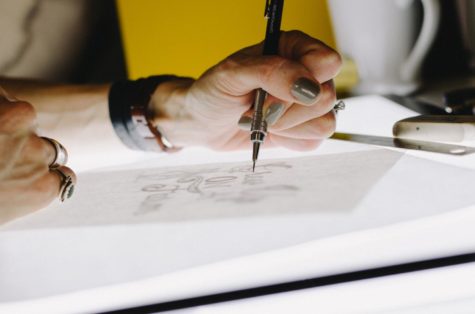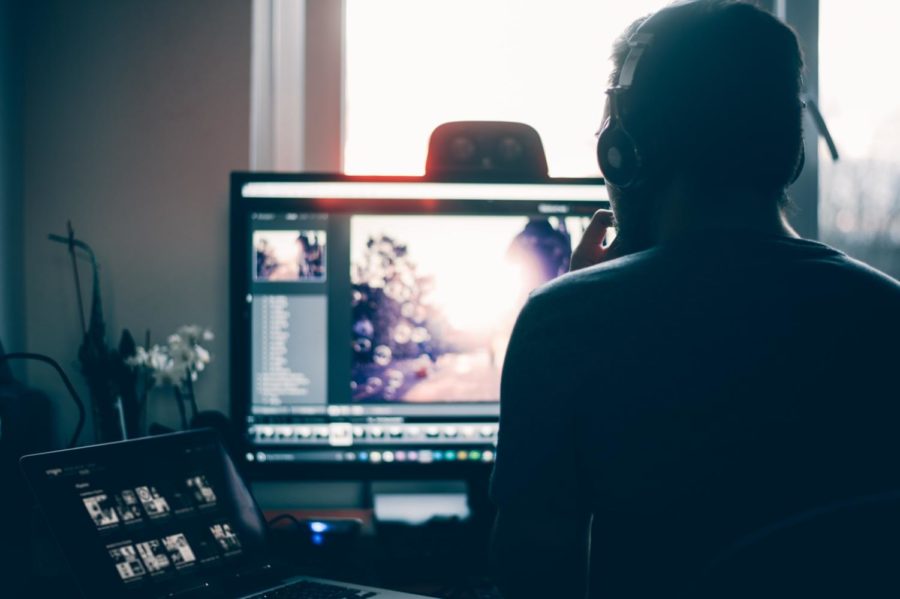The Digital Wave: The Shift From Traditional to Digital Mediums In Art
An analysis in which the creation of art is changing through digital devices, social media, and A1 platforms.
Many people edit photos on their computer using Adobe products. (Photo Credit: Glenn Carstens-Peters / Unsplash)
Our society has steadily been shifting regarding the ways in which it views work. While some millennials may consider work as a means of having a steady income, people are working together to turn their passions into their work. As social creatures, we share thoughts, as well as our feelings, with others — not only to get a sense of comfort, but also to gauge the interests of others. However, during the Coronavirus pandemic, people had to rely largely on the internet to communicate with others. With 3.98 billion people — more than half of the global population —using social media, it is no wonder that we rely heavily on our phones. Our phones and other devices offer many services that people can explore. So people have found convenient ways to express themselves through the internet, with more people turning to the digital art platforms Canva or Adobe to make art instead of their sketchbooks. People are able to express themselves through a computer and show their creations to others. These platforms enabled people to create new connections from the ones that they lost to the Coronavirus pandemic and to obtain the social interaction they sought.
How It Started
Over the past decade. there has been a sharp increase in the amount of people who utilize the internet, and pursuing digital art in particular. All people have to do is pick up their phones or other digital devices and download programs like Canva, Adobe, or Ibispaint, and they can create something. It can be intimidating to try something new, but practice does indeed make perfect, especially when it comes to digital mediums.
Some more well-known softwares are Adobe Illustrator, Krita, Clip Studio Paint and Blender, while digital artists on Instagram like havtza, yoneyamai, Harumaki Gohan, coal_owl, and komugiko_2000 delve into animation and broaden their horizons. Today, digital media is one of the primary sources used to fuel creativity among artists, through the creation of ads, and even through posts on social media. In fact, many people create platforms from their arts and create a small shop. This allows people to explore their passion.
Flexibility With Digital Platforms
Every young artist is faced with the daunting choice of how they will pursue their passion: going to an expensive art institute or freelancing on the side. Many who do choose to go to art school are disappointed, as contrary to their expectations, recruiters aren’t waiting to give them art opportunities, and their portfolios are not showcased.
The previous notion that pursuing art is only filled with difficulty has been broken down with the growth of digital art, and now digital devices have opened new doors for art. With the internet and online software, people can curate an online portfolio on social media, not only for recruiters, but for a community of people who enjoy art. They can utilize Amazon or social media to create an online platform or even create a store. Beyond starting a social media account, they can network with others in their field and host collaborations. These small steps can create new doors for opportunities.
Digital platforms reduce the limitations that come from not having enough money to buy your own store or shop and gives small creators the opportunity to share their work with an audience similar to themselves. They can use stores online to promote their businesses and connect with people internationally. This has opened doors for younger people to pursue passion projects or even start businesses.
Social Conflicts
Beyond art, people can target social issues in the world. Social networks are used by many people to provide newspapers with information, and social media platforms are used to tackle these issues and bring awareness to people suffering from lack of humanitarian aid.
For issues that are known of but not delved into, people use social media platforms to share the event. Then, other people who sympathize can like, share or comment to get others to recognize the issue.

While using a pen and paper to create art creates some nostalgia, digital platforms allow for people to do things in the blink of an eye that would have taken ages to do on paper. These websites offer tools that make the design process much faster like the whip, eyedropper undo, flip, color paint bucket as well as tuning and cool new brush sets. The learning curve from traditional art to digital art may be a bit difficult, but as people often say, ‘practice makes perfect.’
Beyond this, many creators have found that making digital art and animations has allowed them to grow their audiences. These eye-catching and visually appealing art pieces make people excited to see more and show their support. Ever since the Coronavirus pandemic, digital art has become more widespread and has created a sense of reliability because it can be made online, and all a person needs is a device to start creating art. This has enabled many people to create their own connections through the comfort of their screens and to share them with others.
Issues with Digital Mediums
With the introduction of programs like ChatGPT, the opposition towards AI generated artwork has increased. As the opposition increases, so does the number of AI generated artworks fueling anger among artists. Just scroll through a video or post online that claims to be AI generated and read the comments and you can see the outrage.
Just recently, an AI generated picture won an art award at Colorado State Fair’s annual art competition and the creator faced backlash from many artists that claimed “We’re watching the death of artistry unfold right before our eyes.”
The entrant, Jason M. Allen, created the piece using Midjourney, an artificial intelligence program. His work, “Théâtre D’opéra Spatial,” is one of the first AI-generated pieces to win an art prize. This precedent has made many artists fear for the future of art, with one of their primary concerns being if people will buy their work if they can just use AI.
Many artists feel that AI is incapable of producing ‘real’ art, although the capabilities of AI programs can match humans, the amount of time that artists put into their pieces is not apparent with AI generated pieces. Although AI has been around for ages, new programs like DALL-E 2, Midjourney and Stable Diffusion make it possible for novices to create detailed pieces by simply writing a few words or combining some images. Many artists feel as though AI generated art is fake because it is created in a few minutes, in comparison to traditional art that may take hours, if not days, to produce. On top of this, there is the nature in which it is made; many sites combine images or other artworks to create the art. To the eyes of many artists, this classifies as plagiarism because the base of the art was not created by the artist themself. Yet despite these complaints, it is difficult to define what is and what isn’t art.
The Future of Art
Our world is constantly evolving, and with the introduction of new mediums, more people have the resources to express themselves and perfect what they have been practicing. As it changes so will the ways in which art is produced. While the transition from traditional art to digital art may be novel, that does not necessarily mean that that change is bad. The future is unpredictable, and there is no way to tell if things like AI will be welcomed in the art community, because digital art was also looked down upon before it rose to popularity. There are so many things in the world that fit under the label of ‘art’ and the limit to that label does not exist.
Our world is constantly evolving, and with the introduction of new mediums, more people have the resources to express themselves and perfect what they have been practicing.
Mariam Samake is a Chief Graphic Designer and a Copy Chief for ‘The Observatory’ yearbook. She is also a Staff Reporter for 'The Science Survey.' She...

